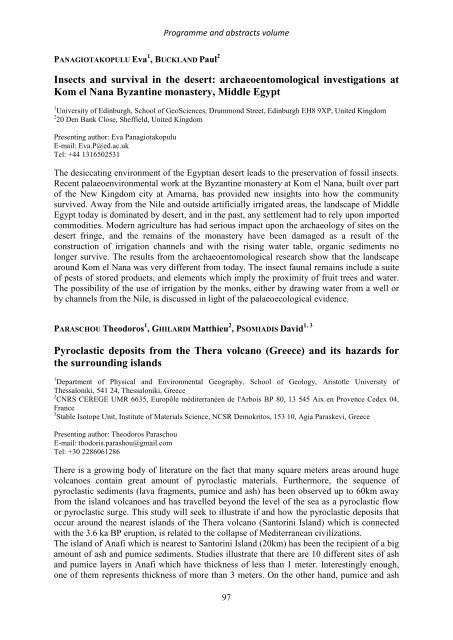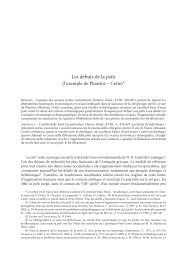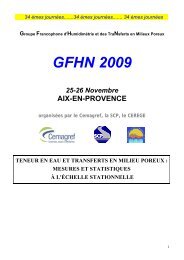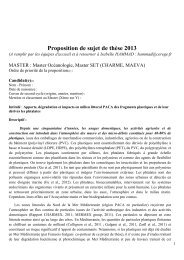LANDSCAPE ARCHAEOlOGY. EGYPT AND THE ... - CFEETK - CNRS
LANDSCAPE ARCHAEOlOGY. EGYPT AND THE ... - CFEETK - CNRS
LANDSCAPE ARCHAEOlOGY. EGYPT AND THE ... - CFEETK - CNRS
You also want an ePaper? Increase the reach of your titles
YUMPU automatically turns print PDFs into web optimized ePapers that Google loves.
Programme and abstracts volume<br />
PANAGIOTAKOPULU Eva 1 , BUCKL<strong>AND</strong> Paul 2<br />
Insects and survival in the desert: archaeoentomological investigations at<br />
Kom el Nana Byzantine monastery, Middle Egypt<br />
1 University of Edinburgh, School of GeoSciences, Drummond Street, Edinburgh EH8 9XP, United Kingdom<br />
2 20 Den Bank Close, Sheffield, United Kingdom<br />
Presenting author: Eva Panagiotakopulu<br />
E-mail: Eva.P@ed.ac.uk<br />
Tel: +44 1316502531<br />
The desiccating environment of the Egyptian desert leads to the preservation of fossil insects.<br />
Recent palaeoenvironmental work at the Byzantine monastery at Kom el Nana, built over part<br />
of the New Kingdom city at Amarna, has provided new insights into how the community<br />
survived. Away from the Nile and outside artificially irrigated areas, the landscape of Middle<br />
Egypt today is dominated by desert, and in the past, any settlement had to rely upon imported<br />
commodities. Modern agriculture has had serious impact upon the archaeology of sites on the<br />
desert fringe, and the remains of the monastery have been damaged as a result of the<br />
construction of irrigation channels and with the rising water table, organic sediments no<br />
longer survive. The results from the archaeoentomological research show that the landscape<br />
around Kom el Nana was very different from today. The insect faunal remains include a suite<br />
of pests of stored products, and elements which imply the proximity of fruit trees and water.<br />
The possibility of the use of irrigation by the monks, either by drawing water from a well or<br />
by channels from the Nile, is discussed in light of the palaeoecological evidence.<br />
PARASCHOU Theodoros 1 , GHILARDI Matthieu 2 , PSOMIADIS David 1, 3<br />
Pyroclastic deposits from the Thera volcano (Greece) and its hazards for<br />
the surrounding islands<br />
1 Department of Physical and Environmental Geography, School of Geology, Aristotle University of<br />
Thessaloniki, 541 24, Thessaloniki, Greece<br />
2 <strong>CNRS</strong> CEREGE UMR 6635, Europôle méditerranéen de l'Arbois BP 80, 13 545 Aix en Provence Cedex 04,<br />
France<br />
3 Stable Isotope Unit, Institute of Materials Science, NCSR Demokritos, 153 10, Agia Paraskevi, Greece<br />
Presenting author: Theodoros Paraschou<br />
E-mail: thodoris.parashou@gmail.com<br />
Tel: +30 2286061286<br />
There is a growing body of literature on the fact that many square meters areas around huge<br />
volcanoes contain great amount of pyroclastic materials. Furthermore, the sequence of<br />
pyroclastic sediments (lava fragments, pumice and ash) has been observed up to 60km away<br />
from the island volcanoes and has travelled beyond the level of the sea as a pyroclastic flow<br />
or pyroclastic surge. This study will seek to illustrate if and how the pyroclastic deposits that<br />
occur around the nearest islands of the Thera volcano (Santorini Island) which is connected<br />
with the 3.6 ka BP eruption, is related to the collapse of Mediterranean civilizations.<br />
The island of Anafi which is nearest to Santorini Island (20km) has been the recipient of a big<br />
amount of ash and pumice sediments. Studies illustrate that there are 10 different sites of ash<br />
and pumice layers in Anafi which have thickness of less than 1 meter. Interestingly enough,<br />
one of them represents thickness of more than 3 meters. On the other hand, pumice and ash<br />
97








